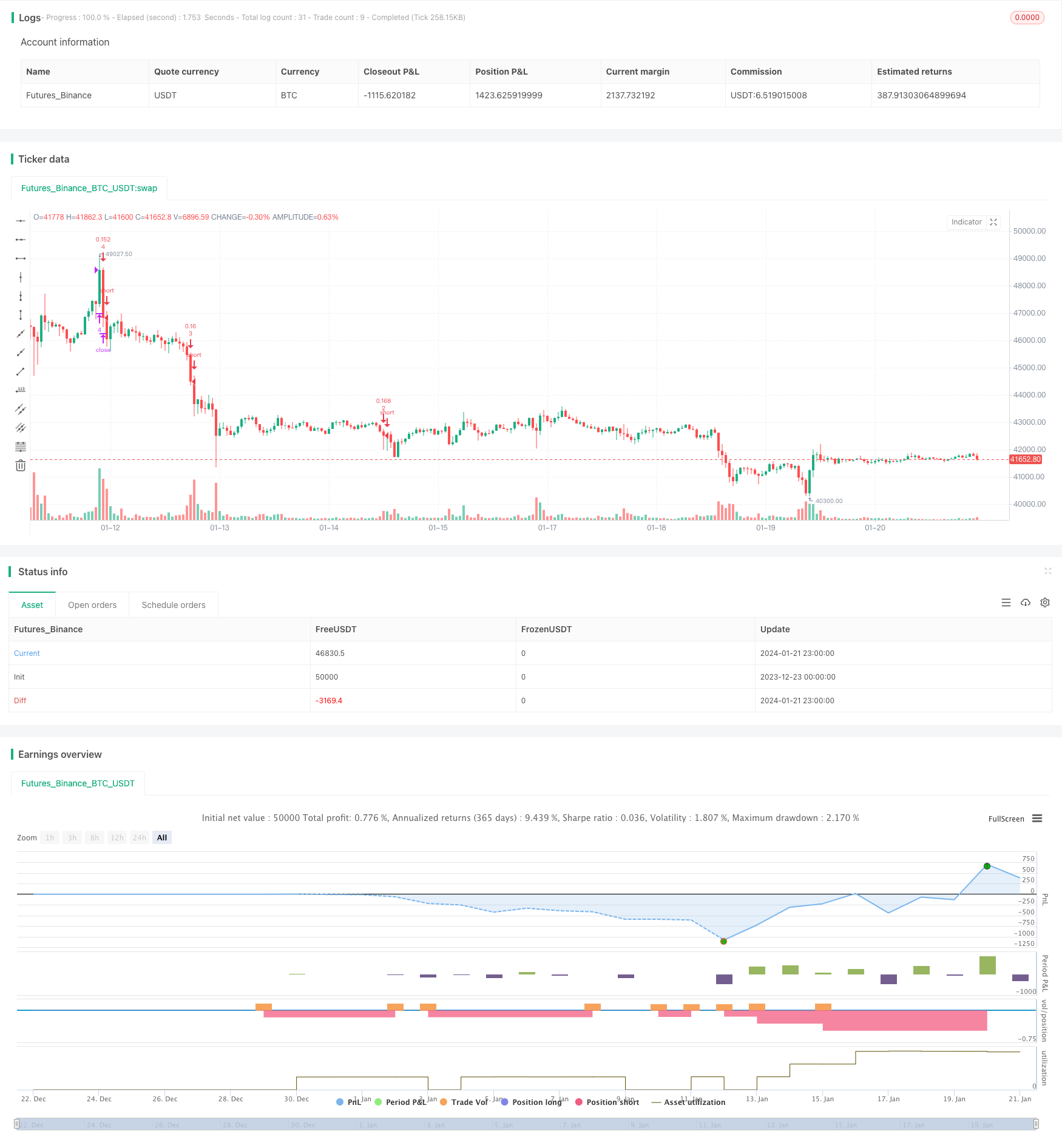
概述
该策略通过在价格区间内设置多条并行的买卖单实现网格交易,根据市场波动调整网格区间和线条,实现盈利。
策略原理
- 设置网格上下界,可以手动设置也可以根据最近一段时间的高低价自动计算。
- 根据设置的网格数量,计算网格区间的宽度。
- 生成对应数量的网格线价格数组。
- 当价格低于某条网格线时,在该线下方开多单;当价格高于某条网格线时,在该线上方平空单。
- 动态调整网格上下界、区间宽度和网格线价格,使其适应市场变化。
优势分析
- 可以在横盘和波动市场实现稳定盈利,不受单边行情影响。
- 支持手动设置也支持自动计算网格区间,适应能力强。
- 可以通过调整网格数量,网格宽度和委托量优化收益。
- 内置仓位控制,可以控制风险。
- 支持动态调整网格范围,使策略具有较强的适应性。
风险分析
- 出现大幅度趋势行情时,可能出现较大亏损。
- 网格数量和仓位设置不当可能导致风险放大。
- 自动计算网格区间在极端行情时可能失效。
风险解决办法:
1. 优化网格参数,严格控制总仓位。
2. 在大幅行情来临前关闭策略。
3. 结合趋势指标判断行情状况,必要时关闭策略。
优化方向
- 结合市场特征和资金规模选择最佳网格数量。
- 测试不同时间周期优化网格自动计算参数。
- 优化委托数量计算方式,以获得更稳定收益。
- 结合其他指标判断大幅行情,设置策略关闭条件。
总结
该动态网格交易策略通过动态调整网格区间参数适应市场变化,实现在横盘和波动盘中获利。同时设置适当的仓位控制可以控制风险。通过优化网格参数以及结合趋势判断指标可以进一步提高策略稳定性。
策略源码
/*backtest
start: 2023-12-23 00:00:00
end: 2024-01-22 00:00:00
period: 1h
basePeriod: 15m
exchanges: [{"eid":"Futures_Binance","currency":"BTC_USDT"}]
*/
//@version=4
strategy("sarasa srinivasa kumar", overlay=true, pyramiding=14, close_entries_rule="ANY", default_qty_type=strategy.cash, initial_capital=100.0, currency="USD", commission_type=strategy.commission.percent, commission_value=0.1)
i_autoBounds = input(group="Grid Bounds", title="Use Auto Bounds?", defval=true, type=input.bool) // calculate upper and lower bound of the grid automatically? This will theorhetically be less profitable, but will certainly require less attention
i_boundSrc = input(group="Grid Bounds", title="(Auto) Bound Source", defval="Hi & Low", options=["Hi & Low", "Average"]) // should bounds of the auto grid be calculated from recent High & Low, or from a Simple Moving Average
i_boundLookback = input(group="Grid Bounds", title="(Auto) Bound Lookback", defval=250, type=input.integer, maxval=500, minval=0) // when calculating auto grid bounds, how far back should we look for a High & Low, or what should the length be of our sma
i_boundDev = input(group="Grid Bounds", title="(Auto) Bound Deviation", defval=0.10, type=input.float, maxval=1, minval=-1) // if sourcing auto bounds from High & Low, this percentage will (positive) widen or (negative) narrow the bound limits. If sourcing from Average, this is the deviation (up and down) from the sma, and CANNOT be negative.
i_upperBound = input(group="Grid Bounds", title="(Auto) Upper Boundry", defval=0.285, type=input.float) // for manual grid bounds only. The upperbound price of your grid
i_lowerBound = input(group="Grid Bounds", title="(Auto) Lower Boundry", defval=0.225, type=input.float) // for manual grid bounds only. The lowerbound price of your grid.
i_gridQty = input(group="Grid Lines", title="Grid Line Quantity", defval=8, maxval=15, minval=3, type=input.integer) // how many grid lines are in your grid
f_getGridBounds(_bs, _bl, _bd, _up) =>
if _bs == "Hi & Low"
_up ? highest(close, _bl) * (1 + _bd) : lowest(close, _bl) * (1 - _bd)
else
avg = sma(close, _bl)
_up ? avg * (1 + _bd) : avg * (1 - _bd)
f_buildGrid(_lb, _gw, _gq) =>
gridArr = array.new_float(0)
for i=0 to _gq-1
array.push(gridArr, _lb+(_gw*i))
gridArr
f_getNearGridLines(_gridArr, _price) =>
arr = array.new_int(3)
for i = 0 to array.size(_gridArr)-1
if array.get(_gridArr, i) > _price
array.set(arr, 0, i == array.size(_gridArr)-1 ? i : i+1)
array.set(arr, 1, i == 0 ? i : i-1)
break
arr
var upperBound = i_autoBounds ? f_getGridBounds(i_boundSrc, i_boundLookback, i_boundDev, true) : i_upperBound // upperbound of our grid
var lowerBound = i_autoBounds ? f_getGridBounds(i_boundSrc, i_boundLookback, i_boundDev, false) : i_lowerBound // lowerbound of our grid
var gridWidth = (upperBound - lowerBound)/(i_gridQty-1) // space between lines in our grid
var gridLineArr = f_buildGrid(lowerBound, gridWidth, i_gridQty) // an array of prices that correspond to our grid lines
var orderArr = array.new_bool(i_gridQty, false) // a boolean array that indicates if there is an open order corresponding to each grid line
var closeLineArr = f_getNearGridLines(gridLineArr, close) // for plotting purposes - an array of 2 indices that correspond to grid lines near price
var nearTopGridLine = array.get(closeLineArr, 0) // for plotting purposes - the index (in our grid line array) of the closest grid line above current price
var nearBotGridLine = array.get(closeLineArr, 1) // for plotting purposes - the index (in our grid line array) of the closest grid line below current price
strategy.initial_capital = 50000
for i = 0 to (array.size(gridLineArr) - 1)
if close < array.get(gridLineArr, i) and not array.get(orderArr, i) and i < (array.size(gridLineArr) - 1)
buyId = i
array.set(orderArr, buyId, true)
strategy.entry(id=tostring(buyId), long=true, qty=(strategy.initial_capital/(i_gridQty-1))/close, comment="#"+tostring(buyId))
if close > array.get(gridLineArr, i) and i != 0
if array.get(orderArr, i-1)
sellId = i-1
array.set(orderArr, sellId, false)
strategy.close(id=tostring(sellId), comment="#"+tostring(sellId))
if i_autoBounds
upperBound := f_getGridBounds(i_boundSrc, i_boundLookback, i_boundDev, true)
lowerBound := f_getGridBounds(i_boundSrc, i_boundLookback, i_boundDev, false)
gridWidth := (upperBound - lowerBound)/(i_gridQty-1)
gridLineArr := f_buildGrid(lowerBound, gridWidth, i_gridQty)
closeLineArr := f_getNearGridLines(gridLineArr, close)
nearTopGridLine := array.get(closeLineArr, 0)
nearBotGridLine := array.get(closeLineArr, 1)